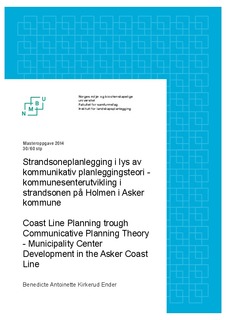| dc.description.abstract | Sammendrag: Denne masteroppgaven søker å besvare hvordan Asker kommune i kommunedelplanen for Holmen – Slependen, vedtatt 29. januar 2013, har klart å forene de tilsynelatende motstridende interessene og hensynene knyttet til en kommunesenterutvikling i 100- metersbeltet langs sjøen på Holmen. I tillegg søker oppgaven å danne et bilde av utfordringer knyttet til å etablere et nytt kommunesenter i strandsonen, som i caset på Holmen tydeliggjøres gjennom den store misnøyen til den vedtatte planen hos lokalbefolkningen og den sentrale private aktøren. Studiet ser også hvordan idealene for kommunikativ planleggingsteori synliggjøres i planprosessen og hvordan disse kan være med på å forene de ulike interessene. Problemstillingen bygger på den økende debatten rundt bærekraftig forvaltning av strandsonen i indre Oslofjord. Presset på strandarealene i indre Oslofjord betegnes som kritisk, og siden 1950-tallet har strandsonen hatt et særskilt vern mot utbygging og privatisering, for å hindre nedgangen i uberørt natur, biologisk mangfold og friluft- og rekreasjonsområder ved sjøen tilgjengelig for allmennheten. Den sterkt økende befolkningsveksten og den økende interessen for strandsonen har gjort et omfattende og strengt lovverk nødvendig. Det har resultert i et generelt byggeforbud i 100-metersbeltet over hele landet, samt gjennom statlige planretningslinjer uttrykker Stortinget at det i indre Oslofjord er nødvendig med en ekstra streng forvaltning av strandsonen i forhold til resten av landet. Forskningsarbeidet utgjør et kvalitativt studie basert på semistrukturerte dybdeintervjuer og et litteratur- og dokumentstudie. I intervjuundersøkelsen ble fire sentrale informanter intervjuet, som hver representerer de mest sentrale aktørene i planprosessen gjeldende en utvikling på Holmen; Fylkesmannen i Oslo og Akershus, saksbehandlere i Asker kommune og den private grunneieren og utvikleren innenfor studieområdet. Litteratur- og dokumentstudie bygger på en studie av kommunikativ planleggingsteori og dokumenter tilhørende kommunedelplanen og dens prosess. Undersøkelsene viser at caset på Holmen er et godt eksempel på at kommunikativ planleggingsteori er utfordrende å gjennomføre i praksis. Til tross for at de offentlige instansene etter loven står i posisjon til å utarbeide, samt vedta en kommunedelplan på bakgrunn av sin kunnskap og kompetanse, hadde kommunen vært tjent med å i større grad innlemme de private aktørene i prosessen. Dette for å bygge tillitt og troverdighet til private aktører som sitter med resursene til å gjennomføre utviklingen kommunen ønsker, i den senere reguleringsprosessen. Likeledes knytter det seg store utfordringer til kommunens planleggerrolle, da de i samme kommunedelplan skal ta hensyn til private aktørers økonomiske- og utviklings interesser på den ene side, og på den annen side Fylkesmannens krav om å sikre statlige og regionale interesser knyttet til landskap, biologisk mangfold og friluftsliv.Abstract:
This master thesis attempts to answer how Asker municipality in the community plan for Holmen – Slependen area, approved 29.01.2013, has managed to join the conflicting interest and consideration tied to the community developing a 100 meter zone along the ocean at Holmen. In addition, the case seeks to create a picture of the challenges tied to establishing a new community center in the coast zone as in the case at Holmen clarified through the large discontent to the approved plan with the local inhabitants and the local private entrepreneurs. The Study also looks into how ideals for communicative planning theory become visible in the planning process and how these can contribute to join the different interests.
The issue builds on the increasing debate around sustainable management of the coast area in the inner Oslo fjord. The pressure on the coast areas in the inner Oslo fjord is described as critical. Since the 1950’s, the coast zone has had the special protection against development and privatization to stop the decline in the fragile nature, biological diversity and recreational areas by the ocean allowing access to the public. The strong increasing population growth and the rising demand on the coast zone has made for a comprehensive and strict legislation necessary. This has resulted in a general ban on building in a 100 meter zone all over the country. Together with governmental planning guidelines, the Parliament expresses that at the inner Oslo fjord is necessary with a strict management of the beach zone in relation to the rest of the country.
The research constitutes a qualitatively study based on semi structural indebt interviews and a literature- and document study. During the survey period, four central informants were interviewed, each representing the most central actors in the planning process of the current development at Holmen; The County representative for Oslo and Akershus, officers in Asker Municipality, the private landowner and developer within the study area. The literature and the documented result is built on a study on a communicative planning theory and documents associated with the community plan and its process.
The survey shows that the case at Holmen is a good example that the communicative planning is challenged in practice. Despite of the governmental departments based on the law stand in a position to prepare, adopt a communal plan on the bases off its knowledge and competence. The Municipal would have been better served in a larger degree by including the private actors in the process. This is to build confidence and credibility to private actors who possess the resources to realize the development the Municipality will have in the later regulating process. Likewise this connects to the big challenges to the Municipal planning role, as in the same, the planners have to consider the private actors economical and developmental interests on one side, and on the other side, the County representatives demands to secure state and regional interests connected to landscape, biological diversity and outdoor recreation. | nb_NO |
